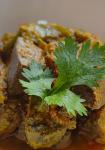A leading archaeologist living in Patna has questioned the Archaeological Survey of India's conclusion, based on its excavation of the disputed site in Ayodhya, eastern Uttar Pradesh, that a large, ancient temple existed below the demolished Babri Masjid.
"The ASI report is partial and far from the truth," Sitaram Rai told rediff.com, insisting that there is no evidence that a temple was demolished and the Babri Masjid built in its place.
![]()
Also Read
![]()
![]()
![]()
![]()
Proof of temple found: ASI![]()
Govt can't be sacrificed for temple: Advani![]()
Patron saint of the movement![]()
![]()
![]()
Rai, one of the experts who had been summoned to give evidence by the Lucknow bench of the Allahabad high court hearing the Ram Janambhoomi-Babri Masjid title suit, said he was surprised to read about the ASI's report.
The former director of Bihar's archaeology department spent more than a fortnight in Ayodhya in June, studying the ASI's methods and the artefacts found at the disputed site. "Mandir hone ka koi bhi evidence nahin hai," he insisted.
The other experts who had been summoned by the Allahabad high court are Suraj Bhan, former head of the department of archaeology, Kurukshetra University (Haryana), D Mandal, former professor of archaeology, Allahabad University, and Shireen Ratnakar, former professor at the Centre for Historical Studies, Jawaharlal Nehru University. "All of us believe," Rai claimed, "that there was no temple at the Ayodhya site."
In March this year, the court ordered the ASI to excavate the site to ascertain whether a Hindu temple pre-dated the mosque that was razed by extremist mobs on December 6, 1992.
According to Rai, from the 13th century on, Muslim artefacts, including coins from the Mughal period, were found in abundance in the entire belt.
The structural remains of broken bricks mentioned by the ASI in its report as proof of the existence of a huge temple represented the habitation of the common masses, particularly Muslims, he claimed. These bricks were brought from outside during the pre-Babri Masjid period.Rai said the ASI had failed to report evidence recovered during the excavation, like whether the disputed site had Muslim habitation around it, that suggested that no previous structure had been demolished to built the Babri mosque.
Rai, who has conducted several archaeological excavations at Nagarjunkonda in Andhra Pradesh, Vaishali in Bihar and Lota Pahar in Singhbhum (Jharkhand), said the ASI report was not objective, flimsy and self-contradictory, and had been prepared under political pressure.
The ASI, whose report was opened by the court on Monday, had shown that "it's saffronised heart is in the right place" with "motivated suggestions and wilful omissions", he claimed.
Rai, who has written about the excavations at Chirand (Saran) and Sonepur in The Encyclopaedia of Indian Archaeology, had appeared as a witness before the Lucknow bench in April 2002.





